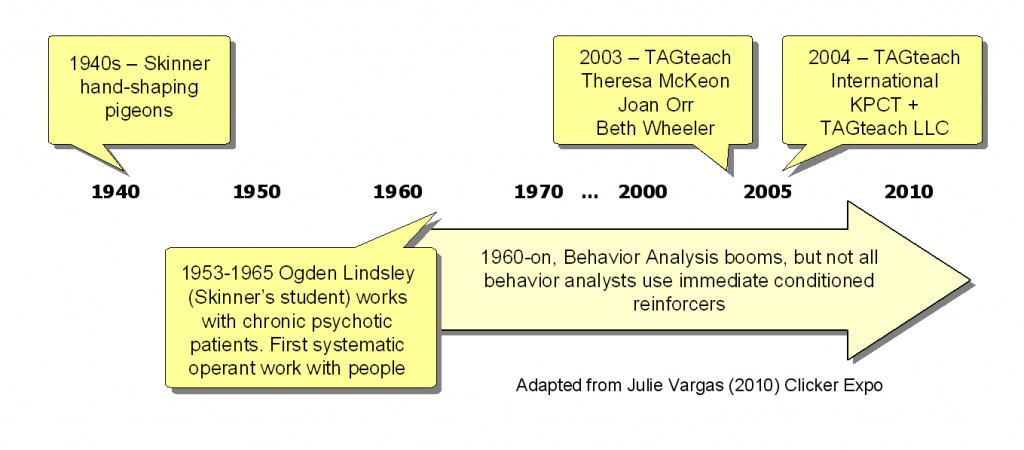What is TAGteach?
TAGteach stands for Teaching with Acoustical Guidance. TAGteach is a teaching and communication method that combines positive reinforcement with an acoustical event marker. TAGteach is an application of behavior science that makes the science of positive reinforcement accessible and easy to do for parents, coaches, teachers and co-workers.
Some areas of application of TAGteach include:
- Corporate training
- Teaching children and adults to play musical instruments
- Skills training for surgeons and nurses
- Physio, occupational and speech therapy
- Teaching skills and social behaviors to non-verbal children with special needs
- Teaching sports skills to children and adults
- Skills training for veterinary professionals
- Customer service skills training
- Self-training for weight loss, smoking cessation, being nicer, exercising more
- Parenting toddlers to teens
- Skills training for elite athletes in many different sports
TAGteach, relies on breaking behavior down into small pieces, looking for desired behaviors and giving positive reinforcement to increase those moments of great behavior. With TAGteach, it’s easy to teach skills to others or even change your own behavior. The goal of this blog is to share TAGteach tools and best practices, so that you can pass on your knowledge and teach others in a way that is effective, efficient and results in success the first time.
Here are two example videos showing TAGteach in sports applications with child and adult learners:
Why do People Love to Be Taught with TAGteach?
Because they get the opportunity to think for themselves and they are never told that they are wrong.
With TAGteach the learner is in control of his own learning. The goal behavior is broken down into tiny achievable steps. Each tiny step is called a tag point and this describes in 5 words or less exactly what the goal is for the next try. Often the learner is involved in choosing the tag point. If he gets his tag point correct, he gets a tag (click) from the teacher. If he gets it wrong, nothing happens and it is up to the learner to self assess and try again. The tag is a positive reinforcer because it is the sound of success. The learner knows he is progressing with the learning and his skill is growing.
Here are some videos showing people talking about what they like about TAGteach:
TAGteach is based on the science of behavior
TAGteach is a science-based approach backed by more than 70 years of research. The principles that underlie the TAGteach approach were discovered by B.F. Skinner in the 1940s and are well-accepted by behavior scientists today. These are the same principles that underlie the science of Applied Behavior Analysis, which has widespread application in all areas of instruction and education.
Here is a timeline adapted from a presentation by Julie (nee Skinner) Vargas PhD:
Dr. Vargas said of TAGteach, “This is what my father would have wanted for his science”.
Compelling scientific evidence, amassed over the last 40 years, demonstrates overwhelmingly that Applied Behavior Analysis (ABA) is a safe and effective approach for working with children with autism. ABA, done well, is fun for kids, focuses on teaching basic skills, and then building up those skills into a bigger behavior repertoire. The more functional behaviors a child can perform and the more he can do, the less frustrated he is and the more enjoyment he gets from life.
Click here for a list of TAGteach references to published and unpublished reports and books on TAGteach.
Here is a video to help you understand more about how TAGteach works. This shows a child with autism learning to go into a pool by himself. At first he needs lots of external positive reinforcement, but soon he gains confidence and the new skill becomes reinforcing on its own. He starts having fun and then he enjoys going into the pool. This is the goal of TAGteach, to teach new skills so that interaction with the world becomes reinforcing on its own and the tagger and treats are no longer required.

